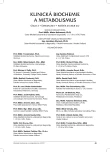External quality evaluation programs at the time of harmonizing laboratory results
Authors:
B. Friedecký 1,2; J. Kratochvíla 1
Authors‘ workplace:
SEKK s. r. o. Pardubice
1; Ústav klinické biochemie a diagnostiky, Fakultní nemocnice, Hradec Králové
2
Published in:
Klin. Biochem. Metab., 25, 2017, No. 2, p. 64-71
Overview
Objective:
Principles of assessment for standardized laboratory methods in contemporary EQA programs in era harmonization
Method:
Publication on the ways of using control limits according to Stockholm declaration and EFLM working group for EQA acceptance limits. Discussion about bias and total error values of measurement results of standardized laboratory methods within last three years.
Results:
Bias and total error values in standardized routine methods, published by different sources show significant degree of agreement. Best situation we can see in case of serum electrolytes measurement except phosphates in some manufacturers. Maximal observed differences between routine methods are in serum enzyme and in lipid (HDL, LDL) measurements. The lack of implementation of standardization is main reason for this situation. Another reason for too big differences may be different analytical quality of routine methods as we can see in case of HbA1c results. Introduced results show clear unsuitability for using „peer group“ values for assessment in EQA programs.
Discussion:
EQA programs are not only tools for reaching accreditation documentation or tool of business politics of manufacturers. They are namely tool for objective and valid determination of analytical quality indicators values for standardized methods and analytes. Basic condition for use of EQA programs as integral part of harmonization process is maximal elimination of using „peer group“ as reference values. Real reference values should be generally used for this purpose.
Keywords:
standardization, EQA programs, bias, total error, harmonization.
Sources
1. Panteghini, M., Sandberg, S.: Defining analytical performance specifications 15 years after the Stockholm conference. Clin Chem Lab Med 2015, 53 : 829-832.
2. Dallas Jones, G. R.: Analytical performance specifications for EQA schemes-need for harmonization. Clin. Chem. Lab. Med., 2015, 53, p. 919-924.
3. Webová adresa: http:// www.westgard.com
4. De Grande, L. A. C., Goossens, K., Van Uytphange, K., Stőckl, D., Thienpont, L. M. The Empower project - a new way of assessing and monitoring test comparability and stability. Clin. Chem. Lab. Med., 2015, 53, p. 1197-1204.
5. Stepman, H. C. M., Tikkainen, V., Stőckl, D., Vesper, H. W., Edwards, S. H., Laitinen, H. et al. Measurement for 8 common analytes in native sera identify inadequate standardization among 6 routine laboratory assays. Clin. Chem., 2014, 60, p. 855-863.
6. Rej, R., Norton-Wenzel, C.S. Assessing analytical accuracy trough proficiency testing: Have effects of matrix been overstated? Clin. Chem. 2015, 61, p. 433-4.
7. Koerbin, G., Tate, J. R., Ryan, J., Jones, G. R., Sikaris, K. A., Kanowski, D. et al. Bias assessment of general chemistry analytes using commutable samples. Clin. Biochem. Rev., 2014, 35, p. 203-11.
8. Van Houcke, S. K., Rustad, P., Stepman, H. C. H., Kristensen, G. B. B., Stőckl, D., Roraas, T. H. et al. Calcium, magnesium, albumin and total protein measurement in serum as assessed with 20 fresh-frozen single-donation sera. Clin. Chem., 2012, 11, p. 1597-1599.
9. Vesper, H. J. W., Wilson, P. W., Rifai, N. A message from the laboratory community to the National Cholesterol Education Program Adult Treatment Panel IV. Clin. Chem., 2012, 58, p. 523-527.
10. Killeen, A. A., Ashwood, E. R., Ventura, C. B., Styer, P. Recent trends in performance and current state of creatinine assays. Arch. Pathol. Lab. Med., 2013, 137, p. 496-502.
11. Weykamp, C., Secchiero, S., Plebani, M., Thelen, M., Cobbaert, C., Thomas, A. et al. Analytical performance of 17 general chemistry analytes across countries and across manufacturers with INPUtS project of EQA organizers in Italy, the Netherlands, Portugal, Uni-ted kingdom and Spain. Clin. Chem. Lab. Med., 2016 DOI:10.1515/cclm-2016-0220.
12. Kaiser, P., Spannagl, M., van Campenhout, Lenge, Y., Siebilder, C., Weykamp, C. et al. HbA1c: EQA in Gemany, Belgium and the Netherlands using fresh whole blood s amples with target values assigned with the IFCC reference system. Clin. Chem. Lab. Med., 2016, 54, p. 1769-1775.
13. Infusino, I., Frusciante, P., Braga, F., Panteghini, M. Progress and impact of enzyme measurement standardization. Clin. Chem. Lab. Med., 2016, DOI:10.1515/cclm-2016-0661.
14. Braga, F., Frusciante, E., Infusino, I., Alonso, E., Guerra, E., Cerriotti, F., Panteghini, M. Evaluation of the trueness of serum alkaline phosphatase measurement in a group of italian laboratories. Clin. Chem. Lab. Med., 2016, DOI:10.1515/cclm-2016-0605.
15. Korzun, W. J., Nilsson, G., Bachmann, L. M., Myers, G. L., Sakurabayashi, I., Nakajima, K. Difference in bias approach for commutability assessment: application to frozen pools of human serum measured by 8 direct methods for HDL and LDL cholesterol. Clin. Chem., 2015, 61, p. 1107-1113.
16. Oliveira, M. J., van Deventer, H. E., Baxchmann, L. M., Warnick, G. R., Nakajima, K., Nakamura, M. Evaluation of four different equations for calculating LDL-C with eight different direct HDL-C assays. Clin. Chim. Acta, 2013, 423, p. 135-140.
17. Mosca, A., Weykamp, C. Standardization of HbA1c: Are all the pieces in place? 17. 11. 2016. CIRME Milano, Italy.
Labels
Clinical biochemistry Nuclear medicine Nutritive therapistArticle was published in
Clinical Biochemistry and Metabolism

2017 Issue 2
-
All articles in this issue
- Laboratory aspects of systemic AA amyloidosis
- MedPed project in Czech Republic
- Interpretation difficulties in electrophoresis and immunofixation findings in patients with multiple myeloma after autologous transplantation
- External quality evaluation programs at the time of harmonizing laboratory results
- 23 cases of Metformin-induced Metabolic Lactic Acidosis in Patients treated with Metformin
- Exercise-induced rhabdomyolysis – frequent cause of false diagnosis
- Clinical Biochemistry and Metabolism
- Journal archive
- Current issue
- About the journal
Most read in this issue
- Exercise-induced rhabdomyolysis – frequent cause of false diagnosis
- 23 cases of Metformin-induced Metabolic Lactic Acidosis in Patients treated with Metformin
- MedPed project in Czech Republic
- Interpretation difficulties in electrophoresis and immunofixation findings in patients with multiple myeloma after autologous transplantation
